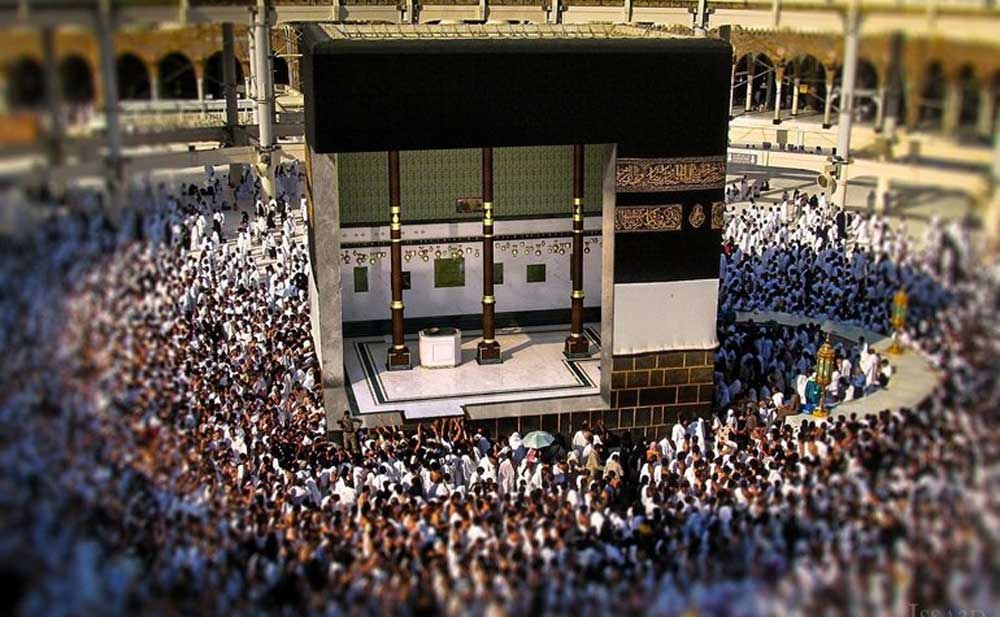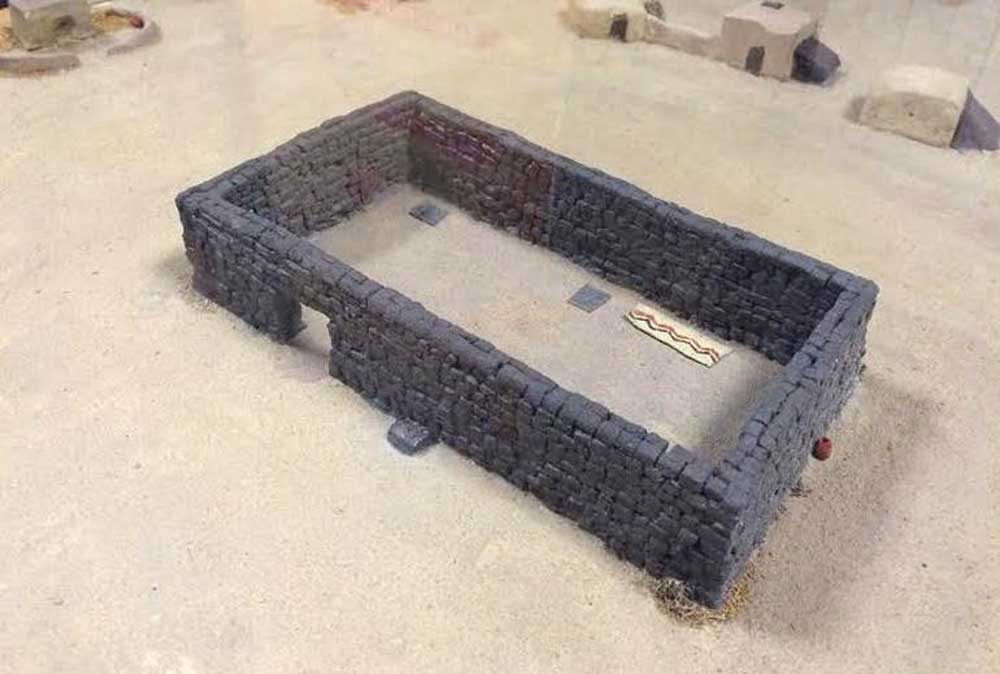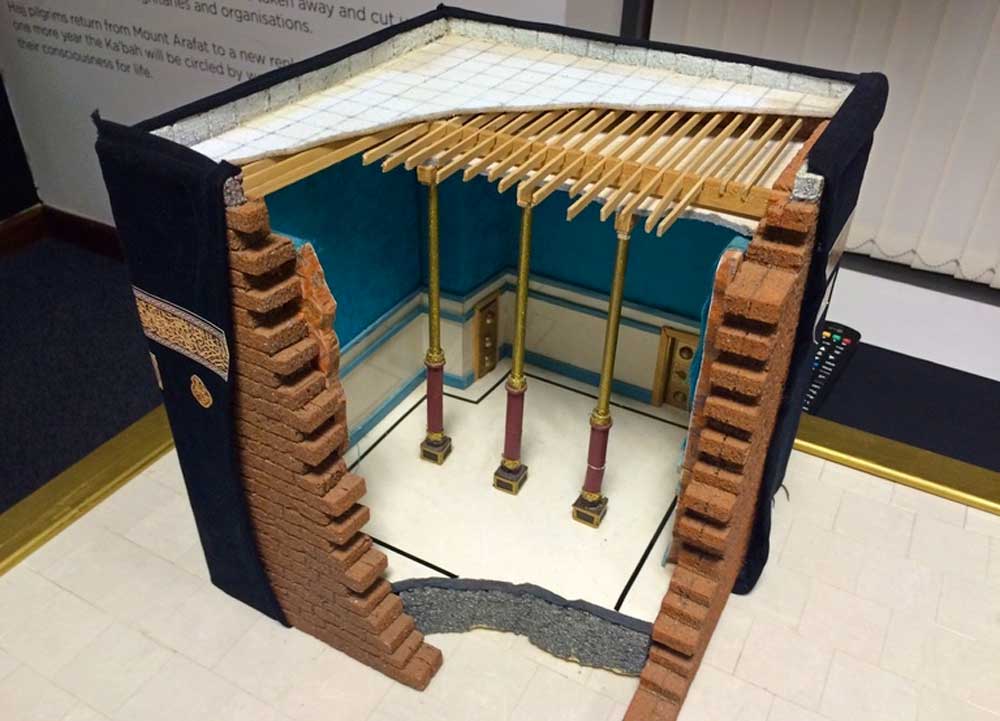Inside the Ka'bah

The diagram above shows a rare view of what the interior of the Ka’ bah looks like. The construction made by Ebrahim (upon him be peace) contained no roof, it was the Quraysh who raised the walls of the Ka’ bah and added a roof. Today, only a privileged few have had the opportunity to step inside the Ka’ bah.
- During the times of Jahiliyyah (Ignorance), a man and woman from the Yemenite tribe of Jurhum called Isaf and Na’ ilah committed adultery inside the Ka’ bah. Allah (Glorified and Exalted is He) turned them into stones. When they were found the next day, they were carried outside and were set up at the Ka’ bah as a warning. Over time these two stones were worshipped along with the other idols. One of the stones was placed right next to the Ka’ bah; the other one was set up at the spring of Zamzam. Finally, the Quraysh ordered that the stone next to the Ka’ bah to be carried to the other one at Zamzam. From then on, people slaughtered their sacrificial animals at that spot.

Model of the Ka'
bah in the time of Prophet Ebrahim (A.S.)
- When Islam began to spread, the Quraysh became more embittered and could not tolerate the Prophet (peace and blessings of Allah be on him) any longer. The chiefs drew up a document which called for the social and economic boycott of the Prophet (peace and blessings of Allah be on him) and all those who supported him and his family. All of them signed this document on 1st Muharram of the seventh year of the Prophethood and the scroll was hung up inside the Ka’ bah to give it full sanctity. For three long years the Prophet (peace and blessings of Allah be on him) and his kinsmen were ostracized in a narrow valley in Mecca. Food was so scarce that they had to resort to eating leaves of trees and their children’ s cries could be heard all over the valley. At last by the Grace of Allah, the scroll was eaten up by white ants save for the name of Allah and the boycott was uplifted.
- When the Prophet (peace and blessings of Allah be on him) arrived in Mecca on the day of victory, he made tawaf around the Ka’ bah seven times and touched the Hajar al-Aswad with his staff. He then asked Uthman bin Talha to open the door of the Ka’ bah. The Prophet (peace and blessings of Allah be on him) entered the Ka’ bah accompanied by Usama bin Zaid, Bilal and Uthman bin Talha (may Allah be pleased with them). He closed the door, performed prayer and stayed for some time.
- Inside the Ka’ bah were statues of Ebrahim (upon him be peace) and Ismail (upon him be peace), along with pictures of angels and a picture of Ebrahim (upon him be peace) with divining arrows in his hand. It has also been reported that there was an icon painting of the Virgin Mary and the child Christ which had been done by a Christian. The Prophet (peace and blessings of Allah be on him) ordered all of them to be destroyed.
- The two horns of the ram which Ebrahim (upon him be peace) slaughtered were hung inside the Holy Ka’ bah. When Abdullah bin Zubair (may Allah be pleased with him) demolished the Ka’ bah to rebuild it, he found the horns had disintegrated due to previous damage and age.
- The Quraysh had erected their chief idol, Hubal, within the centre of Ka’ bah. It was made of red carnelian and shaped like a human with the right hand broken which the Quraysh had replaced with gold. In front of the idol were seven arrows of fate and when the pagan Arabs were undecided on a matter they would go to Hubal and throw the arrows in front of him and took ‘ advice’ based on how the arrows appeared.

Model of the inside of the present Ka’
bah
- Abdul Muttalib, the grandfather of the Prophet (peace and blessings of Allah be on him) had made a vow that if he ever had ten sons he would sacrifice one of them to God in front of the Ka’ bah. When he subsequently fathered ten grown up sons up he announced his vow to them and had their names written on arrows of fate which were mixed and then one drawn out. Destiny fell upon Abdullah, his youngest and dearest son, who was to become the father of the Prophet (peace and blessings of Allah be on him). Not wanting to sacrifice Abdullah, Abdul Muttalib consulted a soothsayer to see how he could be exonerated from his vow and in return for Abdullah’ s life he gave away 100 camels. Hence the Prophet (peace and blessings of Allah be on him) is called the descendant of the “ two sacrificed ones” (Ismail (upon him be peace) and his own father, Abdullah). Similarly, he is referred to as the descendant of the “ two elders held for ransom,” for Ismail (upon him be peace) was ransomed for a ram and his father for a hundred camels.
- The Prophet (peace and blessings of Allah be on him) had Hubal destroyed after the conquest of Mecca.
- Hadhrat Khaarija bin Mus’ ab (Allah show mercy on him) narrates that four people completed the Quran inside the Kaaba in a single rak’ at. Hadrat Uthmaan (may Allah be pleased with him) [2] Hadhrat Tamim Daari (may Allah be pleased with him) [3] Hadhrat Sa’ eed bin Jubayr (may Allah be pleased with him) [4] Imam Abu Hanifa (Allah show mercy on him).